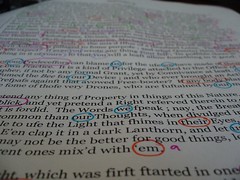“Ze,” the person sitting next to me at the fire said. “Ze,” I repeated tentatively. In my first year of graduate school, I wound up doing fieldwork at a radical environmental conference in the mountains of Oregon. While I learned about setting up roadblocks and doing tree sits, I also learned about gender-neutral pronouns.
Most texts aren’t quite to the point of using “ze.” But, according to a new study by Psychologists Jean Twenge, W. Keith Campbell, and Brittany Gentile, gaps between the use of “he” and “she” in books have narrowed. As a writer from Associated Press explains, the study tracked pronouns in almost 1.2 million texts in Google books archives. In 1950, the ratio of male to female pronouns was roughly 3.5:1. By 2005, it had shrunk to less than 2:1.
“Those numbers are quite staggering,” says James W. Pennebaker, author of The Secret Life of Pronouns and chair of the psychology department at the University of Texas in Austin. “Pronouns are a sign of people paying attention and as women become more present in the workforce, in the media and life in general, people are referring to them more.”
Books by and about women have proliferated in the last half-century. However, more books by women do not mean that more books are getting reviewed or more women are getting to write for literary publications. For example, the nonprofit VIDA: Women in Literary Arts has shown that men receive more space in magazines like The New Yorker and The Atlantic.
The continued prevalence of male writers/male reviewers is “very much the old guard hanging on, as they always do,” Belieu [the Executive Director of VIDA] adds. “But the progressive mind wins in the long ball game.”
And maybe we’ll even more “ze’s” in texts in the future!


Comments